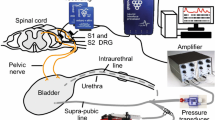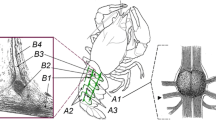Summary
-
1.
Afferent nervous responses to the inflation of the bursa copulatrix in the female cabbage white butterfly,Pieris rapae crucivora, define the information responsible for a behavioural change from acceptance to refusal of mating.
-
2.
Afferent impulses in a pair of nerves (bursal nerves) to both sides of the bursa copulatrix were composed of a single unit in each nerve.
-
3.
In virigin females, the frequency of spontaneous afferent impulses was constant at 1–3/s. If the bursa was filled with a spermatophore after copulation, the impulse frequency increased about ten times. Obviously the enhanced afferent activity carries information about inflation.
-
4.
For experimental analysis, the bursa was inflated artificially by injection of silicone oil. Two response patterns can be separated: phasic during injection, and tonic at sustained expansion.
-
5.
The periodic wave-like contraction of the surface musculature of the inflated bursa occurred spontaneously and presumably myogenically as a result of stretch. As the wave of contraction was propagated, the contralateral portion was extended and consequently the afferent impulses increased temporally. Contraction was also evoked by efferent activities.
-
6.
The frequency of the tonic afferent impulses was maintained near the empty level until the volume of oil injected into bursa exceeded about 3 μl, then it increased so that the impulse frequency is proportional to the logarithm of the volume. The bursa could be swollen to 16 μl in the experiment, while the volume of the normal spermatophore was about 6 μl.
-
7.
The relationship between the volume of the bursa and the mate-refusal response was tested. When normal mating was interrupted, females displayed the mate-refusal posture only if the spermatophore substance ejaculated had been more than half a volume of full spermatophore. An analogous refusal posture was induced when her bursa was expanded by the injection of more than 4 μl silicone oil. These results strongly suggest that the tonic response of the stretch receptor plays the main role in the switch-over of the behaviour.
Similar content being viewed by others
References
Anwyl, R.: The structure and properties of an abdominal stretch receptor inRhodnius prolixus. J. Insect Physiol.18, 2143–2153 (1972)
Bullock, T.H., Horridge, G.A.: Structure and function in the nervous systems of invertebrates. San Francisco and London: Freeman and Company 1965
Clarke, K.U., Langley, P.A.: Studies on the initiation of growth and moulting inLocusta migratoria migratorioides R.&F. III. The role of the frontal ganglion. J. Insect Physiol.9, 411–421 (1963)
Engelmann, F.: The physiology of insect reproduction. Oxford: Pergamon Press 1970
Finlayson, L.H.: Proprioceptors in the invertebrates. Symp. Zool. Soc. Lond.23, 217–249 (1968)
Finlayson, L.H., Lowenstein, O.: A proprioceptor in the body musculature of Lepidoptera. Nature176, 1031 (1955)
Finlayson, L.H., Lowenstein, O.: The structure and function of abdominal stretch receptors in insects. Proc. R. Soc. Lond. (Biol.)148, 433–499 (1958)
Fowler, G.L.: Some aspects of the reproductive biology of Drosophila: sperm transfer, sperm storage, and sperm utilization. Adv. Genet.17, 293–359 (1973)
Gelperin, A.: Stretch receptors in the foregut of the blowfly. Science157, 208–210 (1967)
Gelperin, A.: Abdominal sensory neurons providing negative feedback to the feeding behaviour of the blowfly. Z. vergl. Physiol.72, 17–31 (1971)
Grell, K.G.: Der Darmtraktus vonPanorpa communis L. und seine Anhänge bei Larve und Imago. Zool. Jb. (Anat.)64, 1–86 (1938)
Labine, P.A.: Population biology of the butterfly,Euphydryas editha. I. Barriers to multiple inseminations. Evolution18, 335–336 (1964)
Langley, P.A.: The neuroendocrine system and stomatogastric nervous system of the adult tsetse fly,Glossina morsitans. Proc. Zool. Soc. Lond.144, 415–423 (1965)
Leopold, R.A., Terranova, A.C., Swilley, E.M.: Mating refusal inMusca domestica: effects of repeated mating and decerebration upon frequency and duration of copulation. J. Exp. Zool.176, 353–360 (1971)
Loher, W., Huber, F.: Nervous and endocrine control of sexual behaviour in a grasshopper (Gomphocerus rufus L., Acridinae). Symp. Soc. Exp. Biol.20, 381–400 (1966)
Lowenstein, O., Finlayson, L.H.: The response of the abdominal stretch receptor of an insect to phasic stimulation. Comp. Biochem. Physiol.1, 56–61 (1960)
Nagai, T.: Insect visceral muscle. Response of the proctodeal muscles to mechanical stretch. J. Insect Physiol.16, 437–448 (1970)
Nagai, T., Brown, B.E.: Insect visceral muscle. Electrical potentials and contraction in fibres of the cockroach proctodeum. J. Insect Physiol.15, 2151–2167 (1969)
Obara, Y.: Mating behaviour of the cabbage white,Pieris rapae crucivora. II. The ‘mate-refusal posture’ of the female, (in Japanese). Zool. Mag. (Dobutsugaku Zasshi)73, 175–178 (1964)
Obara, Y.: Humoral factors inducing mate-refusal posture in the female cabbage white butterfly, (in Japanese). Zool. Mag. (Dobutsugaku Zasshi)86, 518 (1977)
Obara, Y., Tateda, H., Kuwabara, M.: Mating behaviour of the cabbage white butterfly,Pieris rapae crucivora Boisduval. V. Copulatory stimuli inducing changes of female response patterns. Zool. Mag. (Dobutsugaku Zasshi)84, 71–76 (1975)
Orlov, J.: Die Innervation des Darmes der Insekten (Larven von Lamellicorniern). Z. Wiss. Zool.122, 425–502 (1924)
Ramalingam, S., Craig, G.B., Jr.: Functions of the male accessory gland secretion ofAedes mosquitoes (Diptera: Culicidae): transplantation studies. Can. Entomologist108, 955–960 (1976)
Takami, T.: In vitro culture of embryos in the silkworm,Bombyx mori L.I. Culture in silkworm egg extract, with special reference to some characteristics of the diapausing egg. J. Exp. Biol.35, 286–296 (1958)
Weevers, R. deG.: The physiology of a lepidopteran muscle receptor. I. The sensory response to stretching. J. Exp. Biol.44, 177–194 (1966)
Weidner, H.: Beiträge zur Morphologie und Physiologie des Genitalapparates der weiblichen Lepidopteren. Z. Angew. Entomol.21, 239–290 (1934)
Zawarzih, A.: Quelques données sur la structure du système nerveux intestinal des insectes. Rev. Zool. Russe1, 176–180 (1916)
Author information
Authors and Affiliations
Additional information
I am indebted to Prof. H. Kinosita for his valuable suggestions and encouragement on this work. My grateful thanks also go to Dr. T. Nagai and Dr. D.G.R. McLeod for critical comments on the manuscript.
Rights and permissions
About this article
Cite this article
Sugawara, T. Stretch reception in the bursa copulatrix of the butterfly,Pieris rapae crucivora, and its role in behaviour. J. Comp. Physiol. 130, 191–199 (1979). https://doi.org/10.1007/BF00614605
Accepted:
Issue Date:
DOI: https://doi.org/10.1007/BF00614605




